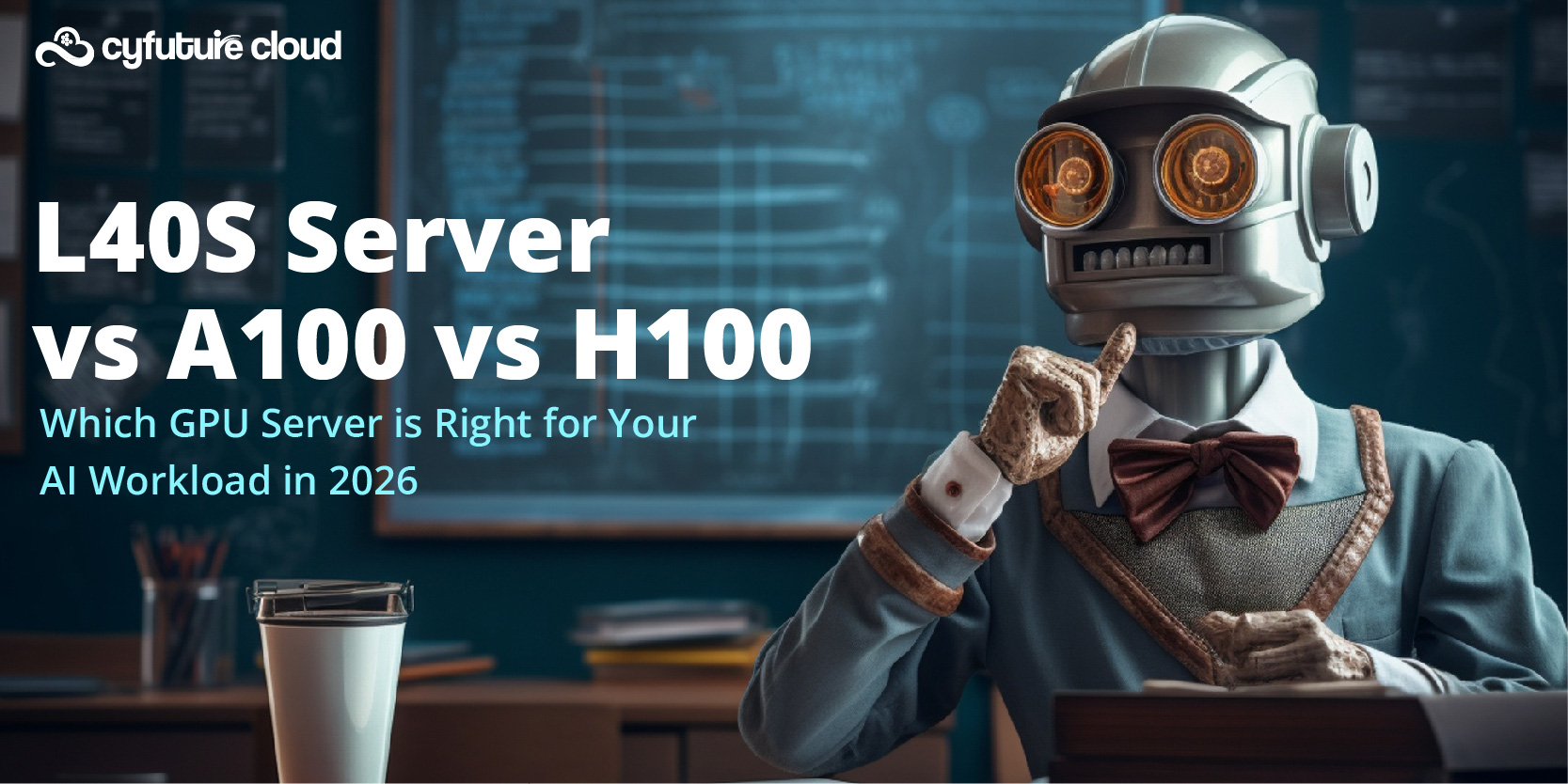Get 69% Off on Cloud Hosting : Claim Your Offer Now!
- Products
-
Compute
Compute
- Predefined TemplatesChoose from a library of predefined templates to deploy virtual machines!
- Custom TemplatesUse Cyfuture Cloud custom templates to create new VMs in a cloud computing environment
- Spot Machines/ Machines on Flex ModelAffordable compute instances suitable for batch jobs and fault-tolerant workloads.
- Shielded ComputingProtect enterprise workloads from threats like remote attacks, privilege escalation, and malicious insiders with Shielded Computing
- GPU CloudGet access to graphics processing units (GPUs) through a Cyfuture cloud infrastructure
- vAppsHost applications and services, or create a test or development environment with Cyfuture Cloud vApps, powered by VMware
- Serverless ComputingNo need to worry about provisioning or managing servers, switch to Serverless Computing with Cyfuture Cloud
- HPCHigh-Performance Computing
- BaremetalBare metal refers to a type of cloud computing service that provides access to dedicated physical servers, rather than virtualized servers.
-
Storage
Storage
- Standard StorageGet access to low-latency access to data and a high level of reliability with Cyfuture Cloud standard storage service
- Nearline StorageStore data at a lower cost without compromising on the level of availability with Nearline
- Coldline StorageStore infrequently used data at low cost with Cyfuture Cloud coldline storage
- Archival StorageStore data in a long-term, durable manner with Cyfuture Cloud archival storage service
-
Database
Database
- MS SQLStore and manage a wide range of applications with Cyfuture Cloud MS SQL
- MariaDBStore and manage data with the cloud with enhanced speed and reliability
- MongoDBNow, store and manage large amounts of data in the cloud with Cyfuture Cloud MongoDB
- Redis CacheStore and retrieve large amounts of data quickly with Cyfuture Cloud Redis Cache
-
Automation
Automation
-
Containers
Containers
- KubernetesNow deploy and manage your applications more efficiently and effectively with the Cyfuture Cloud Kubernetes service
- MicroservicesDesign a cloud application that is multilingual, easily scalable, easy to maintain and deploy, highly available, and minimizes failures using Cyfuture Cloud microservices
-
Operations
Operations
- Real-time Monitoring & Logging ServicesMonitor & track the performance of your applications with real-time monitoring & logging services offered by Cyfuture Cloud
- Infra-maintenance & OptimizationEnsure that your organization is functioning properly with Cyfuture Cloud
- Application Performance ServiceOptimize the performance of your applications over cloud with us
- Database Performance ServiceOptimize the performance of databases over the cloud with us
- Security Managed ServiceProtect your systems and data from security threats with us!
- Back-up As a ServiceStore and manage backups of data in the cloud with Cyfuture Cloud Backup as a Service
- Data Back-up & RestoreStore and manage backups of your data in the cloud with us
- Remote Back-upStore and manage backups in the cloud with remote backup service with Cyfuture Cloud
- Disaster RecoveryStore copies of your data and applications in the cloud and use them to recover in the event of a disaster with the disaster recovery service offered by us
-
Networking
Networking
- Load BalancerEnsure that applications deployed across cloud environments are available, secure, and responsive with an easy, modern approach to load balancing
- Virtual Data CenterNo need to build and maintain a physical data center. It’s time for the virtual data center
- Private LinkPrivate Link is a service offered by Cyfuture Cloud that enables businesses to securely connect their on-premises network to Cyfuture Cloud's network over a private network connection
- Private CircuitGain a high level of security and privacy with private circuits
- VPN GatewaySecurely connect your on-premises network to our network over the internet with VPN Gateway
- CDNGet high availability and performance by distributing the service spatially relative to end users with CDN
-
Media
-
Analytics
Analytics
-
Security
Security
-
Network Firewall
- DNATTranslate destination IP address when connecting from public IP address to a private IP address with DNAT
- SNATWith SNAT, allow traffic from a private network to go to the internet
- WAFProtect your applications from any malicious activity with Cyfuture Cloud WAF service
- DDoSSave your organization from DoSS attacks with Cyfuture Cloud
- IPS/ IDSMonitor and prevent your cloud-based network & infrastructure with IPS/ IDS service by Cyfuture Cloud
- Anti-Virus & Anti-MalwareProtect your cloud-based network & infrastructure with antivirus and antimalware services by Cyfuture Cloud
- Threat EmulationTest the effectiveness of cloud security system with Cyfuture Cloud threat emulation service
- SIEM & SOARMonitor and respond to security threats with SIEM & SOAR services offered by Cyfuture Cloud
- Multi-Factor AuthenticationNow provide an additional layer of security to prevent unauthorized users from accessing your cloud account, even when the password has been stolen!
- SSLSecure data transmission over web browsers with SSL service offered by Cyfuture Cloud
- Threat Detection/ Zero DayThreat detection and zero-day protection are security features that are offered by Cyfuture Cloud as a part of its security offerings
- Vulnerability AssesmentIdentify and analyze vulnerabilities and weaknesses with the Vulnerability Assessment service offered by Cyfuture Cloud
- Penetration TestingIdentify and analyze vulnerabilities and weaknesses with the Penetration Testing service offered by Cyfuture Cloud
- Cloud Key ManagementSecure storage, management, and use of cryptographic keys within a cloud environment with Cloud Key Management
- Cloud Security Posture Management serviceWith Cyfuture Cloud, you get continuous cloud security improvements and adaptations to reduce the chances of successful attacks
- Managed HSMProtect sensitive data and meet regulatory requirements for secure data storage and processing.
- Zero TrustEnsure complete security of network connections and devices over the cloud with Zero Trust Service
- IdentityManage and control access to their network resources and applications for your business with Identity service by Cyfuture Cloud
-
-
Compute
- Solutions
-
Solutions
Solutions
-
 Cloud
Hosting
Cloud
Hosting
-
 VPS
Hosting
VPS
Hosting
-
GPU Cloud
-
 Dedicated
Server
Dedicated
Server
-
 Server
Colocation
Server
Colocation
-
 Backup as a Service
Backup as a Service
-
 CDN
Network
CDN
Network
-
 Window
Cloud Hosting
Window
Cloud Hosting
-
 Linux
Cloud Hosting
Linux
Cloud Hosting
-
Managed Cloud Service
-
Storage as a Service
-
 VMware
Public Cloud
VMware
Public Cloud
-
 Multi-Cloud
Hosting
Multi-Cloud
Hosting
-
 Cloud
Server Hosting
Cloud
Server Hosting
-
 Bare
Metal Server
Bare
Metal Server
-
 Virtual
Machine
Virtual
Machine
-
 Magento
Hosting
Magento
Hosting
-
Remote Backup
-
 DevOps
DevOps
-
 Kubernetes
Kubernetes
-
 Cloud
Storage
Cloud
Storage
-
NVMe Hosting
-
 DR
as s Service
DR
as s Service
-
-
Solutions
- Marketplace
- Pricing
- Resources
- Resources
-
By Product
Use Cases
-
By Industry
- Company
-
Company
Company
-
Company
The future of CDN and its integration with 5G and IoT
Table of Contents
The future of CDN and its integration with other technologies, such as 5G and IoT
Every day, there is a rise in devices connected to 5G and the Internet of Things (IoT). 5G technology is crucial in meeting the demand for better quality and faster networks in CDN. It provides high-quality cellular networking solutions.
Read on to discover how CDN integrates with 5g and IoT integration and what CDN’s future is.
What is a CDN (Content Delivery Network)?
A CDN is a system of geographically dispersed servers optimized to quickly deliver web content. This is achieved by caching a copy of the content on servers near the user’s location.
CDN decreases the distance that the data has to travel, which in turn enhances the speed at which the content is delivered. It is commonly used for transferring images, videos, HTML pages, javascript files, stylesheets, and other large files, but it can also be used to deliver any web content.
CDN services are growing continuously, and currently, the maximum web traffic is served through CDNs, including web traffic from popular sites like Netflix, an OTT platform, Facebook, a social media platform, and Amazon.
A CDN cloud computing, configured correctly, can guard websites against malicious attacks such as DDoS.
Benefits of CDN Cloud Computing
Based on the size and needs of the business, the benefits of CDNs can be divided into different components, which include:
Enhance the load times of the website page
Visitors usually abandon a website if it takes too long to load a webpage content. Content Delivery Network (CDN) services can help improve load times in several ways. That includes;
- CDNs allow for faster service by globally distributing data centers, allowing users to connect to a nearby one instead of the origin server, reducing distance between user and resources.
- CDNs enhance transfer speed through hardware/software optimizations such as efficient load balancing and use of solid-state drives.
- Thirdly, CDNs minimize data transfer by compressing and minifying files, which results in faster load times.
- Lastly, CDNs optimize TLS/SSL certificates and enable TLS false start to speed up sites that use such credentials.
Minimizing bandwidth costs
Bandwidth consumption is a significant expense for businesses. A CDN reduces hosting costs for website owners by using caching and optimizations to decrease the data needed from the origin server, thus using less bandwidth when responding to requests.
Elevating the availability and redundancy of content
One of the crucial things for any internet-based property is uptime. Large amounts of web traffic and malicious attacks cause hardware failures that interrupt normal website function and lead to downtime.
A comprehensive Content Delivery Network (CDN) has features that minimize downtime, such as load balancing to evenly distribute network traffic, intelligent failover to redirect traffic to operational servers in case of hardware malfunction, and Anycast routing to redirect traffic to an available data center if an entire data center experiences technical issues, ensuring continued access to the website for users.
CDN’s distributed nature allows it to handle more web traffic and be more resilient to hardware failures compared to many origin servers. Moreover, if, due to some reason, one or more of the CDN servers go offline, other operational servers can choose the web traffic and keep the service uninterrupted.
Improving website security
When a single web server handles all data transfers, it increases the risk of exposure to malicious events such as Distributed Denial of Service (DDoS) attacks and other vulnerabilities.
DDoS attacks involve coordinated requests for information from multiple locations and users at a specific time, often deployed through bots, to overwhelm the origin server and make the website inaccessible. To protect against these attacks, it is recommended to use DDoS filters and distribute web traffic across multiple locations.
In addition, implementing a CDN can also help protect against hackers and secure sensitive data through data authentication and encryption. This is achieved by deflecting web traffic from the primary server to proxies, making it more difficult for hackers to target the source.
Additionally, using SSL/TLS certificates, which can be purchased or obtained for free from trusted certificate authorities, can further secure information transfers by ensuring that only the intended recipient can access and view the information. Free SSL/TLS certificates are often included in web hosting plans offered by providers.
5g and IoT integration
- Faster delivery:
5g and IoT integration would allow for more immediate delivery of content and services, as 5G networks offer higher bandwidth and lower latency than previous generations of cellular networks.
- Edge computing: CDNs and 5G networks could work together to enable edge computing, allowing for the processing and storage of data closer to the end-user, resulting in faster and more efficient delivery.
- IoT support: CDNs integrated with 5G and IoT would allow for the efficient delivery of data from IoT devices and support the growing number of connected devices.
- Real-time streaming: Integrating CDNs with 5G networks would enable real-time streaming of high-definition video and audio content, improving the user experience.
- Better security: Integrating CDNs with 5G networks would also enhance safety by providing better protection against DDoS attacks and other cyber threats.
- Scalability: CDNs integrated with 5G and IoT would enable the scalability of data and services as the number of connected devices increases, providing an efficient way to handle the growing amount of data.
The future of CDN
According to Technavio, the forecast period for the content delivery network (CDN) market is 2022-2026, with 2021 as the base year. The market is predicted to see substantial expansion, growing by USD 51.23 billion. The compound annual growth rate (CAGR), which gauges the market’s growth rate, is expected to reach 26.84% in the forecast period.
The future of Content Delivery Networks (CDNs) will likely involve a greater focus on personalization and customization and continued expansion and innovation in areas such as edge computing and security.
As more companies and individuals rely on online content and services, there will be an increasing demand for faster and more reliable delivery of that content. This could lead to the development of new technologies and strategies for delivering content, such as using artificial intelligence and machine learning to optimize the delivery process.
CDNs are also expected to play an increasingly important role in protecting against cyber threats, such as DDoS attacks and malware. Overall, the future of CDNs is likely to be characterized by ongoing innovation and evolution as these networks adapt to meet the changing needs of the online landscape.
In conclusion,
The future of CDN cloud computing looks set to be shaped by integrating new technologies such as 5g and IoT integration. These technologies will bring new challenges and opportunities for CDNs and require them to adapt and evolve to meet the demands of the modern internet. Adopting new technologies and utilizing their abilities, CDNs will enhance the performance and accessibility of global content for users.
Recent Post

Stay Ahead of the Curve.
Join the Cloud Movement, today!
© Cyfuture, All rights reserved.
Send this to a friend

 Pricing
Calculator
Pricing
Calculator
 Power
Power
 Utilities
Utilities VMware
Private Cloud
VMware
Private Cloud VMware
on AWS
VMware
on AWS VMware
on Azure
VMware
on Azure Service
Level Agreement
Service
Level Agreement 


















